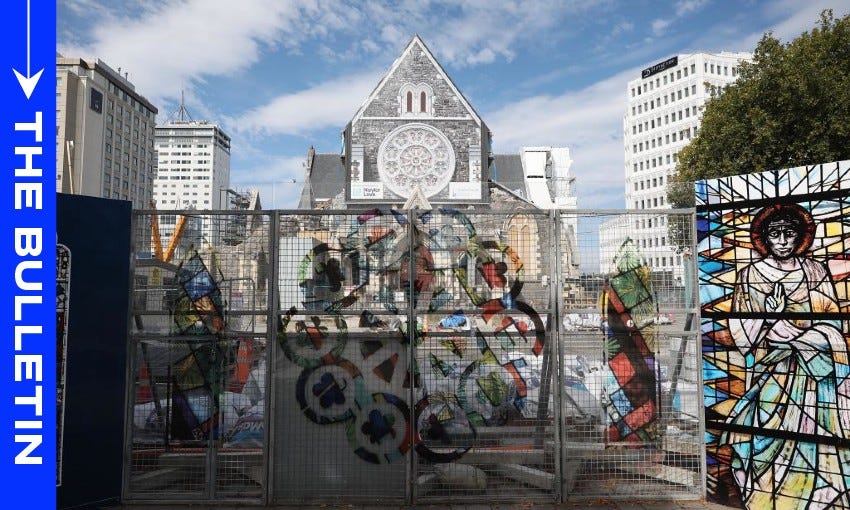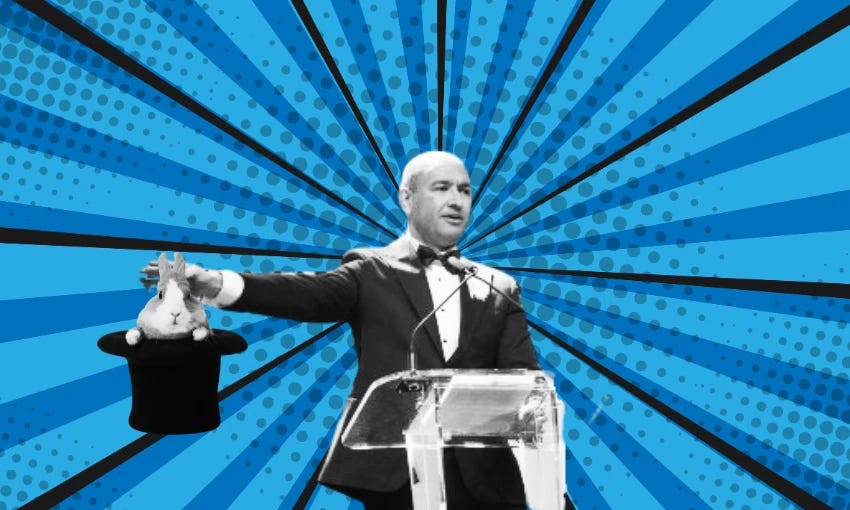How ballooning costs led to the mothballing of the Christ Church Cathedral rebuild
What was once the 'heart of the city' has since become symbolic of the long, slow rebuild.
Mōrena, and welcome to The Bulletin for Wednesday, August 21.
In today’s edition: Kiwibank to be beefed up in wake of ComCom report, 230 jobs to go as Winstone Pulp set to close, and the Labour MP breaking from his party on the issue of beneficiary sanctions. But first, work to rebuild Christ Church Cathedral has been indefinitely paused.

Cathedral rebuild halted
Work to restore the Christ Church Cathedral has been put on ice indefinitely more than a decade after the devastating earthquake hit the garden city. The Press reported that attempts to fill an $85m funding gap necessary to complete the partially under way reconstruction had failed, effectively stopping any further work in its tracks. Those behind the planned rebuild are holding out hope, however, and a demolition isn’t on the cards at this point. The chairperson of Christ Church Cathedral Reinstatement Ltd, Mark Stewart, said: “Mothballing implies abandonment, we are not abandoning the project.”
Nevertheless, hopes of the iconic landmark returning to its former glory in the near future are rapidly slipping away. Kamala Hayman argues in The Press this morning that with the cathedral set to sit mothballed for years, Christchurch now needs to turn its attention to revitalising the neighbouring Square.
Ballooning costs to blame
You probably remember where you were in early 2011 when a 6.3 magnitude aftershock hit Christchurch, resulting in the deaths of 185 people. It’s a moment etched deeply into New Zealand’s history. It was the 2011 quake that most severely damaged the Christ Church Cathedral, crumbling the spire and leaving only parts of the lower building still standing. This 3News footage (shared by the BBC) from the time shows the extent of the damage in the days after the quake. In the years since, parts of the cathedral were demolished for safety reasons, but it wasn’t until 2017 that plans were put into motion to restore the cathedral. At the time, the costs were estimated to be $104m, which ballooned to $154m by 2020. By this year, as Newsroom’s David Williams reported, the projected cost had blown out to $248 million. There was a funding gap of $114m and $30m was urgently needed to continue the strengthening work that was already under way. The final blow came earlier this month: even after the shortfall had been cut to $85m, there was still a gap to be plugged and central government opted not to step in.
The question of heritage
Williams piece captures perfectly why the campaign to save the cathedral resonates with people, for better or worse. He wrote: “In 2012, and for many years beyond, the cathedral was a symbol of the quake’s destruction, and the city’s indecision.” As this Guardian report from 2021 illustrates, the cathedral was (and remains) the “heart of the city”. But what had once been a symbol of strength for the city became symbolic “of all that was wrong with the rebuilding”. In the year’s since the quake, as the city around the cathedral has been rebuilt, the cathedral has become a memorial to the disaster itself. So is there, asked Williams, still appetite to complete the costly rebuild?
As Max Reeves wrote for The Spinoff last week, the cathedral is emblematic of issues that commonly surround heritage protected buildings in Aotearoa. He argued that while heritage buildings are often preserved for historic or architectural reasons, that can also risk preventing change or necessary evolution. In the case of Christchurch, that has meant 13 years with little change to the cathedral while the rest of the city was rebuilt (including the new Cardboard Cathedral not too far away). We’ve seen far starker examples of this in other parts of the country, notably in Wellington where a “rusty oil tanker” was deemed worthy of protection. In the city centre, the Wellington Town Hall has sat empty for several years as costs for earthquake strengthening soared past $300m, as The Spinoff’s Joel MacManus looked at in this excellent feature last year. This Re:News report from earlier in the year provides a good overview of what constitutes a heritage building and why they can cause such consternation.
Protecting the future
In the wake of the quakes, former earthquake recovery minister Gerry Brownlee infamously labelled some buildings “old dungas” that needed to be removed. The current government has expressed some frustration around heritage buildings and how they can stall future development. In announcing his decision on the Wellington District Plan earlier this year, Joel MacManus reported, housing minister Chris Bishop said he wanted to work with councils to find a solution.
Another issue the government is already tackling is around the remediation of earthquake-prone buildings. It has a bill on the books currently that would extend the timeframe to repair buildings at risk of earthquake damage by four years. Public consultation on the lengthily-named “Building (Earthquake-prone Building Deadlines and Other Matters) Amendment Bill” closes in just a few days. It’s an interim measure while a wider review of the earthquake-prone building system initiated by the government is carried out. The minister responsible, Chris Penk, told RNZ’s Morning Report he expected it would ultimately make the rules for addressing earthquake-prone buildings “less onerous”, arguing that “high remediation costs and an excessive layering of regulations" had meant earthquake-prone buildings were not being restored.
Show your support, join up today!
"As a New Zealander living in Sydney, The Spinoff helps me to feel in touch with what's happening back home. There's a great breadth to the content – and the enthusiasm from your contributors is palpable. I feel happy and proud to be a member." Ian, Sydney.
Whether living here or abroad, if you value our work please show your support by becoming a member today.
‘Two-tier oligopoly’: Government agrees to banking sector shake-up
The government has agreed to beef up Kiwibank, reported The Post’s Tom Pullar-Strecker, after receiving the Commerce Commission’s final report into the banking sector yesterday. Finance minister Nicola Willis said the study confirmed that the country’s banking sector was “uncompetitive” and a “highly profitable, two-tier oligopoly”, calling out the behaviour of the country’s four big banks – ASB, ANZ, Westpac and BNZ. Willis wanted Kiwibank to be stronger and “more disruptive”. The government said it will act on all 14 recommendations put forward by the commission, which also included the long-awaited rollout of open banking.
More reading: No really, what is open banking?
Watch: Takeout Kids returns for series two
Takeout Kids is back with the stories of five tamariki and rangatahi growing up in their parents’ shops. In episode one we meet Priyan, who keeps the counter and stock in check at his family’s superette and bulk food store in Auckland. It’s his first week of school, and in class Priyan gravitates to the toy shopfront not unlike his parents’ own, where he plays the pretend version of the job they do for real. Follow Priyan as he deals with lessons in ABCs, cricket and making friends with the return of Takeout Kids.
Made with the support of NZ On Air.
Meet the Anglican bishop fighting fires in his spare time
“When there’s any kind of crisis you want to be there and help,” says Ross Bay, deputy chief of the Auckland Volunteer Fire Brigade. Bay – who is also Anglican Bishop of Auckland – has dedicated his life to helping others, and Z Energy’s Good in the Hood is dedicated to supporting community groups just like his.
Through Good in the Hood, $1 million is shared with community groups across the country, with each store choosing four different community groups to support. Between August 26 and September 22, customers who shop instore can have a say in how the money is split between groups, by voting for their favourite local group with an orange token.
Find out more about how Good in the Hood supports the community here. (sponsored)
Click and Collect
BusinessDesk reports on the proposed closure of Winstone Pulp that would result in the loss of 230 jobs (paywalled).
The Spinoff’s Duncan Greive argues that while the prime minister continues to make basic communication errors, fixating on them risks masking some important truths.
An interesting theory put forward by the Herald’s Claire Trevett in this piece that instead of bringing the Treaty Principles Bill back for a second reading so it can be voted down, the National-led government could opt to let it sit untouched on the order paper and be cleaned up by a future administration.
Labour MP Greg O’Connor has said – twice – that he thinks applying sanctions to young jobseekers is warranted. Party leader Chris Hipkins says that’s not his position. (Stuff)
The PM will urge councils to tighten their own belt before asking central government for help during a speech at this week’s Local Government NZ conference. Meanwhile, councils will be asking the government for new ways to fund themselves – including a so-called “bed tax” on tourists.
Darleen Tana has no intention of resigning from parliament, leaving it in the hands of their former party, the Greens, to decide whether or not to invoke the party-hopping rule.
The Herald’s Michael Morrah has been doing some excellent investigative reporting this week on claims of a toxic work environment at the Civil Aviation Authority. Now, the transport minister could be intervening. (paywalled)
Sir Peter Jackson has been tipped as the new owner of a Lyall Bay mega-block, expanding his property empire in the capital.
Cadence Chung on emerging into the light
“You’re writing something for the New Zealand String Quartet and you’re performing for NZ Opera. Year 9 you wouldn’t have believed that.” Cadence Chung is a 20-year-old university student who’s also an accomplished poet, magazine co-founder, composer and singer.
In the latest instalment of Art Work, she tells us how she stays so productive and the challenges of being an emerging artist. Read it here. (sponsored)
Liam Rātana explains why Te Puni Kōkiri is about to be very, very busy. Alex Casey describes her experience of surviving five hours on Christchurch's first murder mystery train ride. Gabi Lardies breaks down the good and bad of Auckland's newest, sewage-free venue Double Whammy! Emily Draper attends a women's circle to discover if it's woo-woo wellness or crystal-powered connection. For The Cost of Being, a nurse nearing 60 worries about the future as she counts her costs.
That’s it for this morning, thanks for reading. I’ll be back tomorrow.
Want to get in touch? Join the conversation in the Substack comments section or via email at thebulletin@thespinoff.co.nz if you have any feedback on today’s top stories (or anything else in the news).
If you liked what you read today, share The Bulletin with friends, family and colleagues.


















I find it a deplorable state of affairs that the Christchurch Cathederal remains in ruins. This is not about support for religious institutions but rather about respecting and maintaining heritage sites. I felt the same way about the Catholic Cathedral also lost due to the earthquake and financial constraints. When Notre Dame suffered the catastrophic fire, the rebuild was never seriously in doubt. What is wrong with New Zealand that it places so little value on heritage and such a huge value on the worship of mammon?